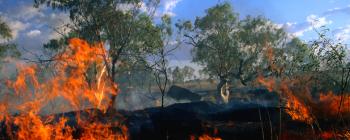
What does a hotter planet mean for wildfires?
Climate change affects wildfires by exacerbating the hot, dry conditions that help these fires catch and spread.
As global temperatures rise, we expect the size, frequency and severity of wildfires to increase in the years ahead.
Parts of the world are already experiencing increases in weather conducive to wildfires. And in places from California to the Siberian Arctic, we’ve seen record-breaking wildfires.
What causes wildfires?
Wildfires are unplanned fires that burn in forests, grasslands and other ecosystems, and they can start with a natural event like a lightning strike, or by accident as the result of human activity. Campfires, discarded cigarettes, and electrical equipment like downed power lines all spark wildfires.
But climate change — along with poor forest management — can make environments more susceptible to burning. Severe heat and drought, which are worsening due to climate change, can fuel wildfires.
Hotter temperatures evaporate more moisture from soil and vegetation, drying out trees, shrubs and grass and turning leaf litter and fallen branches into kindling.
In times of drought, trees that are stressed by a lack of water may also become more vulnerable to insects and diseases that can weaken or kill them, creating more fuel for fires.
And in the western U.S., snowpacks are shrinking and melting earlier in the year, which makes forests more flammable by reducing the water available for vegetation.
Fire is a natural phenomenon that serves important ecological purposes, clearing dead and diseased plants from some forests, for example, and even helping some plants reproduce.
But a rapidly warming planet — along with a history of short-sighted forest management practices and land use decisions that push development into the wilderness — is contributing to catastrophic fires.
Fighting wildfires by fighting climate change
Extreme wildfires are devastating communities and ecosystems. We can help reduce risks through better forest management and community planning.
But we also must work together to fight harmful fires by curbing the greenhouse gas emissions that are warming our planet. We know how to cut climate pollution to create a safer world for future generations, and the time to act is now.
FAQ: Wildfires and climate change
Actually, we don’t want to prevent or put out every wildfire. Fire is a natural phenomenon that serves important ecological purposes, and some wildfires are beneficial for ecosystems.
But climate change and other factors are contributing to uncontrolled, catastrophic fires that damage ecosystems, harm communities, and kill residents and firefighters.
Steps we can take to help prevent extreme wildfires and the societal and environmental damage they cause include cutting greenhouse gas emissions, improving forest management and learning to better prepare for fire. Thinking carefully about where we live and build infrastructure is also important.
For people interested in ways to help prevent wildfires that are accidentally set by humans, many government agencies, such as the National Interagency Fire Center in the U.S., publish guides.
Reducing greenhouse gas emissions is crucial because climate change not only affects wildfires, but also intensifies other extreme weather disasters like hurricanes, heatwaves and droughts.
We must slow climate change by breaking the world’s dependence on oil and gas — and we must do everything we can to slash planet-warming methane emissions.
Stopping tropical deforestation, boosting soil health on farms and restoring wetlands are also powerful natural climate solutions. Healthy forests, soil and wetlands can reduce global emissions and store CO2.
Wildfires happen on every continent except Antarctica, and climate change is increasing wildfire risks.
A 2022 United Nations Environment Programme report on wildfires notes that these fires “are burning longer and hotter in places they have always occurred, and are flaring up in unexpected places too, in drying peatlands and on thawing permafrost.”
The effects of climate change on wildfires will vary by region, and climate change is not the only factor influencing wildfire threats. But overall, the U.N. report projects that the risk of extreme wildfires will surge in a warming world.
For information on where wildfires are actively burning around the world, NASA provides a map showing fires, including wildfires, that are observed by satellites.
A map of current wildfires and smoke in the U.S. is available through a partnership between government agencies.
As climate change increases wildfire risks, concerns about dangerous air quality from wildfire smoke are growing, too. Air pollution from wildfires can travel thousands of miles, as it did in 2023, when parts of the East Coast of the United States were shrouded in smoke from wildfires in Canada’s boreal forest.
As EDF air quality scientist Tammy Thompson explained, “The heat from these larger fires is sending smoke, black carbon, nitrogen oxides and hydrocarbons into the atmosphere, where they can react and form other harmful pollutants, such as ozone.
“Often, the larger fires have enough heat and upward momentum to send their plumes into the free troposphere — above the ground-level layer of air — where there are fewer removal pathways and stronger upper-level winds. This is one reason they can travel such long distances.”
People in the U.S. can learn about air quality in their area by viewing a map of current wildfires and smoke.
Thompson notes that when large wildfires destroy towns, they burn homes and other structures containing human-made materials that can release even more toxic pollutants, making air quality even worse.
Air pollution from wildfires can cause and worsen cardiovascular and respiratory problems, including asthma attacks. Children, pregnant people, older adults and people with chronic conditions like heart disease or asthma are particularly vulnerable to the health effects of wildfire smoke.
People who work outdoors, such as agricultural workers, are also especially vulnerable to severe impacts from wildfire smoke.
Steps we can take to protect our health during periods of heavy wildfire smoke include staying indoors and keeping indoor air as clean as possible, ideally using a high-efficiency particulate air (HEPA) purifier. If we must spend time outdoors, an N-95 or P-100 respirator-type mask can lower our exposure to particulate matter.
Learn more about wildfires and extreme weather
Media contact
Hilary Kirwan
(202) 572-3277 (office)
















